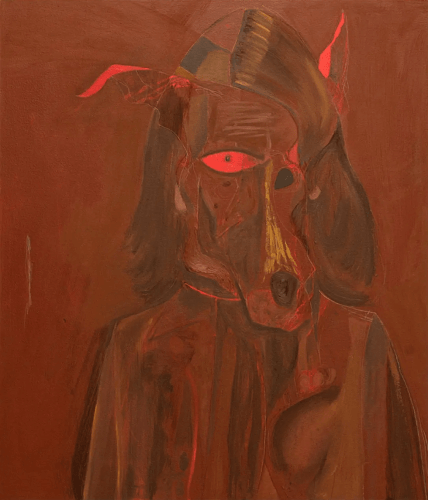
Painting—both the process and its products—can be absurd, irreverent, and funny, as the 20-plus “portraits” by Jason Fox presented at CANADA suggest. CANADA, an artist-owned and artist-operated gallery space in the Lower East Side, recently welcomed Fox to its repertoire of under-recognized painters. A well-educated (The Cooper Union, Columbia M.F.A.) and well-exhibited (Peter Blum Gallery, N.Y.C.) painter, Fox has avoided the overly-refined, too-precious, too-serious paintings that have come to haunt the contemporary art world. His concept is simple: paint what you love, and paint it over and over.
With the exception of “George & John” (2013), which spells out both Beatles’ names in a concentric, collapsing circle, Fox’s paintings are fresh. Indeed, Fox made all of the works in Supernaturalism within the past two years. The portraits are paintings, but they read more like sketches, even under-paintings. His strokes are assured, his pencil marks apparent, and the white substrate often left uncovered. The paintings are confident, despite—or perhaps because of—their casualness. They seem to be quickly rendered, in some instances almost bordering on large doodles. “Don’t Shoot Me, I’m Crazy” (2014) particularly maintains the fluidity and freedom of a sketch, offering viewers an access point into Fox’s mind: its figure holds his arms up in innocence, yet he is also a pastiche of a multi-armed Hindu god and a Christian saint with angel wings and stigmata hands who wears some version of a Viking helmet.
CANADA’s architecture splits the show into two rooms. In the first room, Fox’s work seems stiffer, heavier, his paintings made predominantly with earthy browns, greens, and yellows. It is in the second room where Supernaturalism lives up to its title. Here, the artist’s work becomes psychedelic and hot. Fox has made red paintings for years, and the red canvases, especially “Our House” (2014) and “Untitled”(2013), an Obama/Marley portrait, burn at high internal temperatures. Like after-images, their sizzling impressions remain on our retinas long after we look away.
Fox does not limit himself to figurative work, and he achieves the heat of his red paintings with the two monochrome works featured in Supernaturalism: the yellow “Man on the Sun” (2014) and the green “Hudson” (2014). In the other two abstract works—both “Untitled” (2014)—Fox mutes his colors to grays and blues. Though quieter, these two pieces betray a consistency of method and touch. Here, as with his figurative paintings, Fox paints transparently, using graphite marks as the boundary edge to contain his color. The abstract works seem like interludes, breaks necessary for Fox’s studio practice, and as such, they offer a reprieve from the otherwise loaded imagery.
The show also demonstrates how much Fox has let go of many of the qualities that characterize his older work: the structured, tightly drawn, almost obsessively-rendered figures made of hundreds of marks that are really small, contained shapes. Whereas his older paintings often depict two figures in the middle of some intense, mysterious, emotional interaction, here he shows a single figure in multiple positions. We can identify distinct features but not necessarily the bodies they are attached to: three eyes, four ears, five legs, and six arms. The single dog in “Our House” could be a Siamese twin with one body, two heads, and four legs.
Though the openness of these new paintings might mark a departure in his work, Fox has been riffing on the same themes for the past few years. His “Untitled” portrait (2014), hung in the first room, merges John Lennon’s facial structure with George Harrison’s long hair. Portions of both faces are recognizable, yet they fuse into a new person, albeit one with green eyes. Only one portrait in Supernaturalism is named after a specific individual. Titled “Michael” (2014), it too seems to grow out of an earlier Fox combination: “Barack Obama and Bob Marley” (2010), featured in Peter Blum’s 2012 exhibition, Eating Symbols. In CANADA’s “Untitled” (2014) iteration of the Obama/Marley combination, Fox makes blatant the joint/cigarette lifted by a hand with a few too many fingers.
There is little doubt that Fox is intrigued by peculiar, idiosyncratic combinations that can seem far afield: Obama/Marley, Vishnu/angel, figuration/color field. The key to Fox’s juxtapositions seems to lie in what he sees, and the similarities suggested by the visual. His paintings reflect a suggestive and organic, rather than deeply conceptual, process. If there are underlying psychosocial implications in Fox’s portraits, they do not announce themselves loudly, especially since only familiarity with the artist’s earlier work clues the viewer in to his sustained interest in this mash-up. Otherwise, “Michael” seems to be just that: a dude named Michael smoking something held up to his mouth by his or someone else’s hand. It is this very randomness that makes these well-executed paintings irreverent.